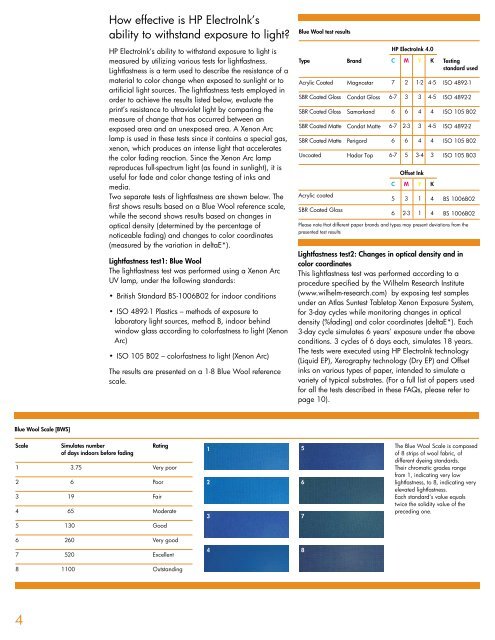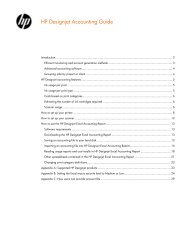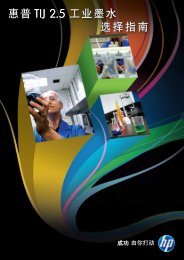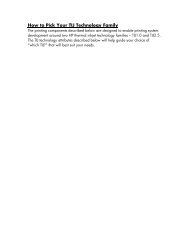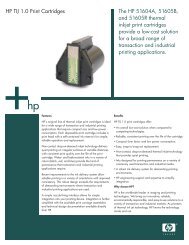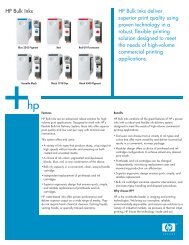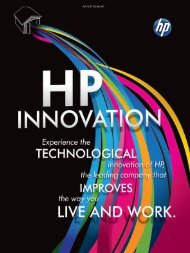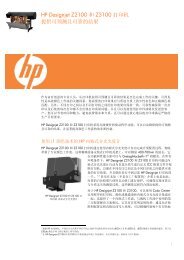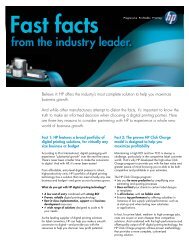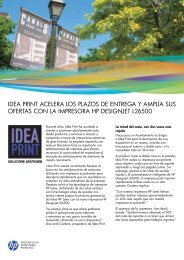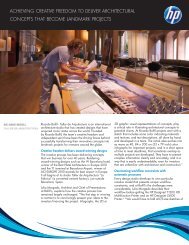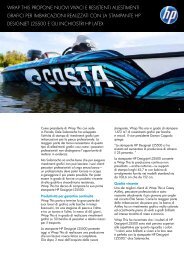HP ElectroInk Frequently Asked Questions - Hewlett Packard
HP ElectroInk Frequently Asked Questions - Hewlett Packard
HP ElectroInk Frequently Asked Questions - Hewlett Packard
Create successful ePaper yourself
Turn your PDF publications into a flip-book with our unique Google optimized e-Paper software.
Blue Wool Scale [BWS]<br />
Scale Simulates number Rating<br />
of days indoors before fading<br />
1 3.75 Very poor<br />
2 6 Poor<br />
3 19 Fair<br />
4 65 Moderate<br />
5 130 Good<br />
6 260 Very good<br />
7 520 Excellent<br />
8 1100 Outstanding<br />
4<br />
How effective is <strong>HP</strong> <strong>ElectroInk</strong>’s<br />
ability to withstand exposure to light?<br />
<strong>HP</strong> <strong>ElectroInk</strong>’s ability to withstand exposure to light is<br />
measured by utilizing various tests for lightfastness.<br />
Lightfastness is a term used to describe the resistance of a<br />
material to color change when exposed to sunlight or to<br />
artificial light sources. The lightfastness tests employed in<br />
order to achieve the results listed below, evaluate the<br />
print’s resistance to ultraviolet light by comparing the<br />
measure of change that has occurred between an<br />
exposed area and an unexposed area. A Xenon Arc<br />
lamp is used in these tests since it contains a special gas,<br />
xenon, which produces an intense light that accelerates<br />
the color fading reaction. Since the Xenon Arc lamp<br />
reproduces full-spectrum light (as found in sunlight), it is<br />
useful for fade and color change testing of inks and<br />
media.<br />
Two separate tests of lightfastness are shown below. The<br />
first shows results based on a Blue Wool reference scale,<br />
while the second shows results based on changes in<br />
optical density (determined by the percentage of<br />
noticeable fading) and changes to color coordinates<br />
(measured by the variation in deltaE*).<br />
Lightfastness test1: Blue Wool<br />
The lightfastness test was performed using a Xenon Arc<br />
UV lamp, under the following standards:<br />
• British Standard BS-1006B02 for indoor conditions<br />
• ISO 4892-1 Plastics – methods of exposure to<br />
laboratory light sources, method B, indoor behind<br />
window glass according to colorfastness to light (Xenon<br />
Arc)<br />
• ISO 105 B02 – colorfastness to light (Xenon Arc)<br />
The results are presented on a 1-8 Blue Wool reference<br />
scale.<br />
1<br />
2<br />
3<br />
4<br />
Blue Wool test results<br />
Type<br />
Acrylic Coated<br />
SBR Coated Gloss<br />
SBR Coated Gloss<br />
SBR Coated Matte<br />
SBR Coated Matte<br />
Uncoated<br />
Acrylic coated<br />
SBR Coated Gloss<br />
Please note that different paper brands and types may present deviations from the<br />
presented test results<br />
Lightfastness test2: Changes in optical density and in<br />
color coordinates<br />
This lightfastness test was performed according to a<br />
procedure specified by the Wilhelm Research Institute<br />
(www.wilhelm-research.com) by exposing test samples<br />
under an Atlas Suntest Tabletop Xenon Exposure System,<br />
for 3-day cycles while monitoring changes in optical<br />
density (%fading) and color coordinates (deltaE*). Each<br />
3-day cycle simulates 6 years’ exposure under the above<br />
conditions. 3 cycles of 6 days each, simulates 18 years.<br />
The tests were executed using <strong>HP</strong> <strong>ElectroInk</strong> technology<br />
(Liquid EP), Xerography technology (Dry EP) and Offset<br />
inks on various types of paper, intended to simulate a<br />
variety of typical substrates. (For a full list of papers used<br />
for all the tests described in these FAQs, please refer to<br />
page 10).<br />
5<br />
6<br />
7<br />
8<br />
Brand<br />
Magnostar<br />
Condat Gloss<br />
Samarkand<br />
Condat Matte<br />
Perigord<br />
Hadar Top<br />
<strong>HP</strong> <strong>ElectroInk</strong> 4.0<br />
C<br />
7<br />
6-7<br />
6<br />
6-7<br />
6<br />
6-7<br />
C<br />
5<br />
6<br />
M<br />
2<br />
3<br />
6<br />
2-3<br />
6<br />
5<br />
M<br />
3<br />
2-3<br />
Y<br />
1-2<br />
3<br />
4<br />
3<br />
4<br />
3-4<br />
Offset Ink<br />
Y<br />
1<br />
1<br />
K<br />
4-5<br />
4-5<br />
4<br />
4-5<br />
4<br />
3<br />
K<br />
4<br />
4<br />
Testing<br />
standard used<br />
ISO 4892-1<br />
ISO 4892-2<br />
ISO 105 B02<br />
ISO 4892-2<br />
ISO 105 B02<br />
ISO 105 B03<br />
BS 1006B02<br />
BS 1006B02<br />
The Blue Wool Scale is composed<br />
of 8 strips of wool fabric, of<br />
different dyeing standards.<br />
Their chromatic grades range<br />
from 1, indicating very low<br />
lightfastness, to 8, indicating very<br />
elevated lightfastness.<br />
Each standard’s value equals<br />
twice the solidity value of the<br />
preceding one.


